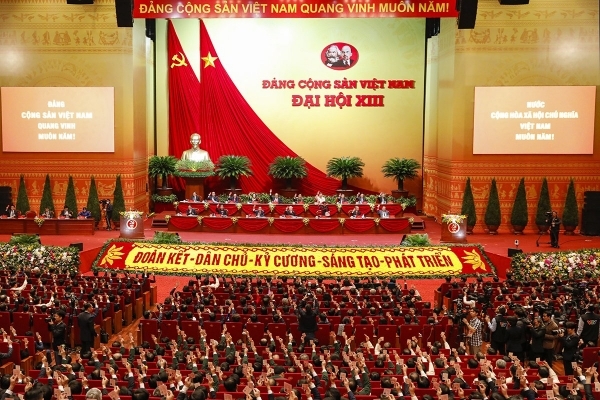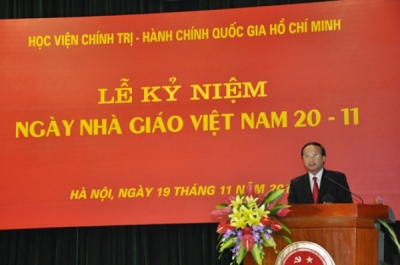Leadership vision and strategic thinking at the new quest
(LLCT) - : Vision and strategic thinking are important and decisive qualities of a leader. Forming a vision and training strategic thinking is one of the leaders' tasks in order to meet the increasing requirements of national development in reality. The article focuses on clarifying the vision and strategic thinking needed for leaders nowadays.
Keywords: leader, leadership vision, strategic thinking, strategic level cadres.
In its Resolution No. 26-NQ/TW dated May 19, 2018, the Party Central Committee clearly stated the objectives: Building a contingent of cadres, especially strategic leveled cadres whose qualities, capabilities, prestige are suitable with their tasks; ensuring sufficiency in quantity, quality and structure which are consistent with the socio-economic development strategy and national safeguarding; ensuring a continuous and steady transition between generations, in order to lead the country to become a modern industrial country by 2030, with a vision to become a modern, socialist-oriented industrial country by 2045, for the purpose of building wealthy people, and a strong country with democracy, justice, civilization, more prosperity and happiness.
1. Vision and leadership vision
Vision is an individual’s perception of the world around him and about himself. Vision includes awareness, consciousness, inspiration, dreams, and such at different levels, depending on the individual’s knowledge, living experience in reality as well as the objective conditions which are independent from human wills.
Leadership vision - the vision of a leader (politician, leader, top commander, the chief, the director of an organization, etc..) is the perception of the future image of objective reality, the perception of the movement trends of the surrounding world, of the environment in which the organization or institution exists; an awareness of the future of an organization or institution led by himself/herself with goals and objectives that can and should be achieved; the determination of the way to that future.
A leadership vision has a number of characteristics. It is a vision that carries the challenge of a positive, feasible change; arouses great emotions; defines the focus clearly; an integration of reality and ideal, turning the leader into the one who raises “the seeds of hope” as Napoleon described; a guide to all steps; a future snapshot from the present.
Researchers of leadership in the world have generalized that the leadership vision always includes the following element visions:
Long-term vision: the ability to see the goal in the far future; the ability to face reality with a future idea; to outlook the focal points ahead; to identify opportunities and challenges; to design strategies, roadmaps, steps, etc..
Direct vision: the ability to see directly into reality, not to avoid disadvantages, to approach all issues with strong will and enthusiasm; from there, managing and using time in the most effective way.
Internal vision: the ability to see and evaluate oneself. Besides the innate talent, a leader must practice to acquire more and more leadership qualities. In order to lead people to successfully implement their chosen goals and path, the leader must self-evaluate and understand what his/her strengths, and weaknesses.
Peripheral vision: the ability to observe, look sideways on the roadmap to realize its goals and path to promptly identify partners, allies, opponents, and enemies.
Retrospective vision: the ability to reflect on the past, to evaluate the past properly, to summarize lessons learned from the past and such, then based on that in order to move forward.
Ambient vision: the ability to see in 360 degrees to accurately assess the overall team who accompany you. In a broad sense, leadership is building a team that will continue the career. Therefore, this vision is related to the nature of leadership.
Artificial vision: the ability to observe, perceive, evaluate through the use of methods, tools, equipment, etc.
Night vision: ability to observe, recognize and evaluate in dark and unfavorable circumstances, when lack of information, time, and many other conditions. In this situation, only a leader who has rich practical experience, outstanding instincts, modern leadership skills, and such can create by himself an effective navigation system.
Vision is very important for the leader and leadership. If leadership is understood as the establishing of vision, creating inspiration to the majority about that vision and goal, passionately devoting to achieving the chosen goals and path, vision is the first essential factor that creates a leader. The number-one quality of a leader is to feel, realize, recognize in advance and clearly about the trends, prospects, and movement of the world around when all others have not seen them or seen in a very vague way. Therefore, the leadership vision is initially often the vision of the minority, even of a single individual, and then it is shared, disseminated, and thoroughly understood by the majority.
Leadership means the possession of power, the using of power. Power is an intrinsic factor, the foundation of leadership. The power of a leader does not arise purely from the position and resources at hand. Correct, timely and profound vision is the first fundamental factor that creates the power of a leader. Evaluating reality correctly helps to improve and develop it. It is imperative to thoroughly look at your surroundings to explore the right way, to assess the objective trend to identify goals, objectives, and paths, and to recognize the situation to remain in the right direction. The result of all these actions creates the power of the leader, who regularly has to make sure that the work is done in the right direction. This is different from the way of the manager who has to make sure the work is carried out as planned, with quality and efficiency.
2. Strategic thinking of leaders
Thinking is a unique human activity, a product of a special organized matter, the human brain. Thinking is a process of perceiving the world objectively, from sensory perception to rational cognition, from specific visual thinking to general abstract thinking through a system of concepts, laws and regulations. Thinking is deployed by people in all areas of human life, including ordinary thinking and scientific thinking. Thinking is a category of social consciousness, always determined by social existence, first of all the physical economic conditions.
Strategy is the term originally used in the military field, means macro goals, a system of great combat plans and the fighting method of the entire army to win a war. Below strategy is the campaign related to one or more battlefields; followed by the tactic related to a particular battle.
Later on, the concept of strategy was widely applied in economic fields, particularly to business activities. For example, the production - business strategy for business is: adhering to its mission, correctly and promptly identifying strategic goals in each specific context, along with strategic scope, and mottos, plan, resources, etc. to implement in order to gain a competitive advantage in the market.
Nowadays, the concept of strategy is applied in all sectors and at many different levels (private, corporate, local, industry, sector, national, regional, international, global).
In general, strategy is defining the overall vision and priority, fundamental, long-term goal that needs to be achieved; identifying the space required for that strategy, the advantages to make use of, and the disadvantages to avoid; outlining the guideline of action and the core principles and values to be followed in the implementation of the strategy; preparing resources, roadmaps and action plans; assigning responsibilities and fields of work to each group or individual; foreseeing number of uncertain situations and contingency plans, etc..
Strategic thinking is the distinctive quality, capability and activity of a leader, mainly senior leaders and the top leader. That is the macro and generalized thinking of the vision and strategic goals; on how far away from the current position to the target; on strategic space and analysis, comparison between advantages and disadvantages; on the strategic motto and roadmap; on resources and implementation plan; on responsibility assignment of instruction and guidance; on estimations of some uncertainties and contingency plans, etc.
The most important elements of strategic thinking include the perception of the strategic goal, the strategic space, the strategic motto, the strategic roadmap and resources to implement the strategy.
The strategic goal is the goal attached to the mission of each organization or institution; the vital goal that makes the organization and institution assert its existence and position in each specific period or time.
The strategic motto is the direction, way of action, direction and leadership throughout and consistent in the strategy implementation.
The roadmap is the determination of stages, steps, milestones for completing major works, including identifying priority steps, breakthroughs and decisive steps.
The resources required for the implementation of the strategy are often huge and varied: human and financial resources, physical and mental resources, local and external resources, short-term and long-term resources, national and international, public and private resources, and such.
Lacking vision and strategic thinking, leadership becomes a stalemate and ultimately loses power, in spite of possibly receiving people’s respect. Lack of vision will lead both leader and his fellows into inappropriate strategies and policies, even into a crisis on the way and mode of action. Stagnation, shortcomings, difficulties and socio-economic crisis in socialist countries at the end of the twentieth century were caused deeply by the lack of vision on the scientific and technological revolution, which emerged from the 1970s and has created a turning point in the movement of human society, firstly in material production industry, then in all areas of social life in each country as well as in the world.
The renovation from 1986 up to now, strategically, is the process of renewing the vision of the entire Party, the entire people, first of all the leading cadres and managers at all levels. We have bravery and wisdom enough to build vision which is straightforward to the truth on assessing the country’s situation; a correct vision of the world as the only environment in which the Party and our people continue to build and defend the Fatherland; a flexible vision of peace, cooperation and development as the world’s trend, and so on. Thanks to these visions, our innovation policies and paths have paved the way for our country to get out of crisis, stand firm and develop, overcome harsh challenges, and achieve historically significant outcomes.
In response to the requirement of a new mission by mid-20th century, the training of vision and strategic thinking for leadership cadres, especially strategic-level cadres (both current and future ones), is an urgent and pivotal task. Thus, it is necessary to thoroughly grasp and implement the following fundamental requirements:
Promptly building vision and strategic thinking to serve the work of building and defending the Socialist Fatherland; at the same time, adjusting, supplementing and elaborating vision and strategic thinking according to the movement of reality. The work of building and defending the Fatherland of the entire Party and people has been deployed in light of complicated, sudden and unpredictable uncertainties in the world. Nations in the world are now competing with each other more and more fiercely, and critically in terms of resources, conditions and development advantages. Delay in building vision and strategic thinking means failure in development and being lagged behind further. On the other hand, if we fail to adjust, supplement and elaborate vision and strategic thinking, we may stand still or deviate towards mistakes, crisis and bankruptcy.
Harmoniously combining objectivity, reality, feasibility with creative capacity, inspiration, and subjective will in building vision and strategic thinking of each individual as well as of the entire contingent of strategic leveled cadres. Leadership vision is predominant; strategic thinking is to make the seemingly impossible things possible. Therefore, it requires the cadre to firmly put his feet on the ground, but he can imagine, dream, forecast, judge and resolve in mind, etc..
For 35 years of renovation, Vietnam has entered a new development period of a middle income country. This is not only a new step in the process of innovation, integration and development but also a new history page of Vietnam which put an end to thousands of years of poverty and backwardness to enter the era of development.
The world today is in the industrial revolution 4.0, a world of globalization, and digitalization, shifting its center of development to the Asia - Pacific region and urgently requiring all people to obtain strategic thinking of sustainable development; a world of conflicts, opposites, but increasing integration into a global production - business chain, etc.. The world now very different from the it was 5-10 years ago. It is an urgent requirement for us to grasp these things in mind in order to build the country’s strategic-level contingent.
Improving the organization’s capacity to successfully implement vision and strategic thinking in order to successfully complete the strategic objectives and tasks of the country, ministries, sectors, fields, localities, organizations. Of great significance, this is decisive to the success or failure of the cause of building and defending the Socialist Fatherland with a vision to the mid-21st century.
Vision and strategic thinking in Vietnam are reflected in the Platforms, lines, orientations, strategies and major policies of the Party and State, which are specified in the goal for “a prosperous people, strong country, fair, democratic and civilized society”; to become a modern oriented industrial country by 2030, with a vision to 2045 of becoming a modern socialist-oriented industrial country; and directly reflected in the strategies for national protection, international integration, industrial agricultural, educational and training development, and environmental protection, and so on.
“Cadres are the roots of all jobs; every success or failure is due to good or bad cadres”, affirmed President Ho Chi Minh. A good cadre must have a bright soul and mind with vision; must be virtuous and talented, moral and professional, in which the leadership vision and strategic thinking are indispensable and undelayable. Looking at the successful countries in the world today, we can see the prerequisite role of the head of state and his/her talented leadership team who has a vision and strategic thinking which keep up with the demands of the 21st century. History will demand from us even more in the years to come!
Assoc.Prof., Dr. Nguyen Viet Thao
Institute of Leadership and Public Policy
Ho Chi Minh National Academy of Politics
Journal Archives
Journal Archives
Media
Photo Gallery
Contact us






